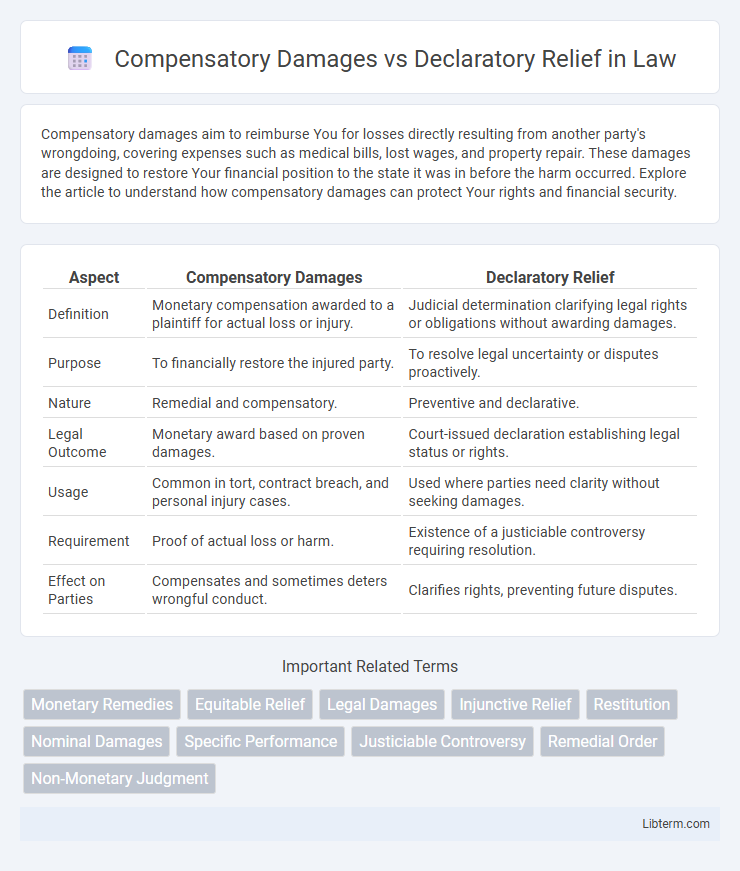Compensatory damages aim to reimburse You for losses directly resulting from another party's wrongdoing, covering expenses such as medical bills, lost wages, and property repair. These damages are designed to restore Your financial position to the state it was in before the harm occurred. Explore the article to understand how compensatory damages can protect Your rights and financial security.
Table of Comparison
| Aspect | Compensatory Damages | Declaratory Relief |
|---|---|---|
| Definition | Monetary compensation awarded to a plaintiff for actual loss or injury. | Judicial determination clarifying legal rights or obligations without awarding damages. |
| Purpose | To financially restore the injured party. | To resolve legal uncertainty or disputes proactively. |
| Nature | Remedial and compensatory. | Preventive and declarative. |
| Legal Outcome | Monetary award based on proven damages. | Court-issued declaration establishing legal status or rights. |
| Usage | Common in tort, contract breach, and personal injury cases. | Used where parties need clarity without seeking damages. |
| Requirement | Proof of actual loss or harm. | Existence of a justiciable controversy requiring resolution. |
| Effect on Parties | Compensates and sometimes deters wrongful conduct. | Clarifies rights, preventing future disputes. |
Understanding Compensatory Damages
Compensatory damages are monetary awards intended to reimburse plaintiffs for actual losses suffered due to another party's wrongful conduct, including tangible costs like medical expenses, property damage, and lost wages. These damages are calculated based on evidence proving the extent and value of the harm, aiming to restore the injured party to the position they occupied before the injury. Unlike declaratory relief, which seeks a judicial determination of rights without awarding money, compensatory damages provide direct financial compensation for proven damages.
Defining Declaratory Relief
Declaratory relief is a judicial determination that clarifies the rights, duties, or obligations of parties without ordering any specific action or awarding monetary damages. Unlike compensatory damages, which compensate the plaintiff for losses suffered, declaratory relief resolves legal uncertainties to prevent future disputes. Courts issue declaratory judgments to establish legal relationships and guide parties' conduct under the law.
Legal Foundations: Damages vs Relief
Compensatory damages are monetary awards intended to restore the plaintiff to the position they would have been in had the harm not occurred, grounded in tort and contract law principles. Declaratory relief, by contrast, is a judicial determination that clarifies legal rights or obligations without ordering any specific action or awarding monetary compensation, originating from equity law. While damages address harm through financial compensation, declaratory relief resolves legal uncertainties by defining the parties' rights and duties.
Key Differences Between Compensatory Damages and Declaratory Relief
Compensatory damages provide monetary compensation to a plaintiff for actual losses suffered due to the defendant's actions, aiming to restore financial position before the harm. Declaratory relief, by contrast, seeks a court's determination on the rights or legal obligations of parties without awarding money, clarifying legal relationships or status. While compensatory damages address past harm, declaratory relief primarily prevents future disputes by legally defining parties' rights.
Situations Warranting Compensatory Damages
Situations warranting compensatory damages typically involve cases where a plaintiff has suffered quantifiable financial loss, physical injury, or property damage due to another party's negligence or breach of contract. Courts award compensatory damages to restore the injured party to the position they would have been in had the harm not occurred, encompassing medical expenses, lost wages, and repair costs. Unlike declaratory relief, which clarifies legal rights without awarding monetary compensation, compensatory damages directly address the tangible impact of the wrongdoing.
When is Declaratory Relief Appropriate?
Declaratory relief is appropriate when parties seek a court's determination of their legal rights, status, or obligations without requiring monetary compensation or enforcement actions. It is commonly used to prevent future disputes by clarifying contractual ambiguities, statutory interpretations, or constitutional questions. Unlike compensatory damages, which address harm already suffered, declaratory relief provides a proactive resolution to legal uncertainty.
Legal Procedures for Claiming Each Remedy
Compensatory damages require filing a lawsuit where the plaintiff must prove actual harm or loss caused by the defendant's actions, supported by evidence such as contracts, invoices, or medical reports. Declaratory relief involves petitioning the court to establish the rights and obligations of parties without seeking monetary compensation, often through motions or complaints initiated to clarify legal status or resolve uncertainties. Legal procedures for compensatory damages emphasize fact-finding and damage quantification, while declaratory relief focuses on legal interpretation and the prevention of future disputes.
Pros and Cons: Compensatory Damages vs Declaratory Relief
Compensatory damages provide monetary compensation for actual losses, offering a clear financial remedy, but they can be difficult to quantify accurately and may not address future rights or obligations. Declaratory relief establishes legal rights or clarifies obligations without awarding monetary damages, which helps prevent future disputes but does not provide immediate financial compensation. The choice between compensatory damages and declaratory relief hinges on whether the priority is financial recovery or legal clarity.
Real-World Case Examples
In the landmark case of Hadley v. Baxendale, compensatory damages were awarded to cover the actual loss due to delayed shipment, emphasizing financial restitution for breach of contract. In contrast, in the landmark case of OAKWOOD V. FUHR, declaratory relief was sought and granted to establish the legality of property boundaries without awarding monetary damages. These cases illustrate how courts use compensatory damages to address quantifiable losses while declaratory relief resolves legal uncertainties in disputes.
Choosing the Right Legal Remedy
Choosing the right legal remedy depends on the nature of the harm and the desired outcome, where compensatory damages aim to financially reimburse the plaintiff for actual losses incurred. Declaratory relief provides a judicial determination of legal rights or obligations without ordering any specific action or awarding damages. Evaluating whether monetary compensation or a formal legal clarification best resolves the dispute is essential in selecting between compensatory damages and declaratory relief.
Compensatory Damages Infographic

 libterm.com
libterm.com